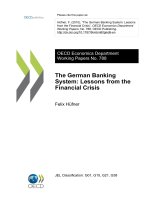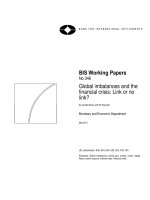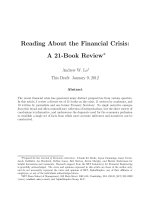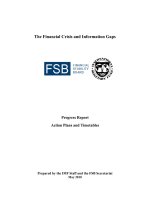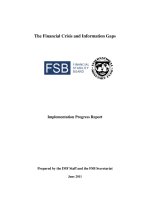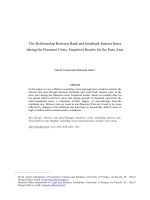oecd - the financial crisis, reform and exit strategies (2009)
Bạn đang xem bản rút gọn của tài liệu. Xem và tải ngay bản đầy đủ của tài liệu tại đây (477.43 KB, 103 trang )
XXXPFDEPSHQVCMJTIJOH
CRISIS REFORM MARKETS
MARKETS
REFORM
CRISIS
REFORM MARKETS CRISIS
REFORM
CRISIS
MARKETS
REFORM
CRISIS
MARKETS
MARKETS CRISIS REFORM MARKETS CRISIS REFORM
CRISIS
MARKETS
REFORM
CRISIS
MARKETS
REFORM
CRISIS
MARKETS
REFORM
CRI
CRISIS REFORM MARKETS CRISIS REFORM MARKETS CRISIS REFORM MARKETS
MARKETS
REFORM
CRISIS
MARKETS
REFORM
CRISIS
MARKETS
REFORM
CRISIS
MARKETS
REFORM
CRISIS
MARKETS
REFORM
C
REFORM MARKETS CRISIS REFORM MARKETS CRISIS REFORM MARKETS CRISIS REFORM MARKETS CRISIS R
REFORM
CRISIS
MARKETS
REFORM
CRISIS
MARKETS
REFORM
CRISIS
MARKETS
REFORM
CRISIS
MARKETS
REFORM
CRISIS
MARKETS
REFORM
CRISIS
MARKETS
MARKETS CRISIS REFORM MARKETS CRISIS REFORM MARKETS CRISIS REFORM MARKETS CRISIS REFORM MARKETS
CRISIS
MARKETS
REFORM
CRISIS
MARKETS
REFORM
CRISIS
MARKETS
REFORM
CRISIS
MARKETS
REFORM
CRISIS
MARKETS
REFORM
CRISIS
MARKETS
REFORM
C
CRISIS REFORM MARKETS CRISIS REFORM MARKETS CRISIS REFORM MARKETS CRISIS REFORM MARKETS CRISIS REFO
MARKETS
REFORM
CRISIS
MARKETS
REFORM
CRISIS
MARKETS
REFORM
CRISIS
MARKETS
REFORM
CRISIS
MARKETS
REFORM
CRISIS
MARKETS
REFORM
CRISIS
M
REFORM MARKETS CRISIS REFORM MARKETS CRISIS REFORM MARKETS CRISIS REFORM MARKETS CRISIS REFORM M
REFORM
CRISIS
MARKETS
REFORM
CRISIS
MARKETS
REFORM
CRISIS
MARKETS
REFORM
CRISIS
MARKETS
REFORM
CRISIS
MARKETS
REFORM
CRISIS
MARKETS
MARKETS CRISIS REFORM MARKETS CRISIS REFORM MARKETS CRISIS REFORM MARKETS CRISIS REFORM MARKETS C
CRISIS
MARKETS
REFORM
CRISIS
MARKETS
REFORM
CRISIS
MARKETS
REFORM
CRISIS
MARKETS
REFORM
CRISIS
MARKETS
REFORM
CRISIS
MARKETS
REFORM
C
CRISIS REFORM MARKETS CRISIS REFORM MARKETS CRISIS REFORM MARKETS CRISIS REFORM MARKETS CRISIS REF
MARKETS
REFORM
CRISIS
MARKETS
REFORM
CRISIS
MARKETS
REFORM
CRISIS
MARKETS
REFORM
CRISIS
MARKETS
REFORM
CRISIS
MARKETS
REFORM
CRISIS
M
REFORM MARKETS CRISIS REFORM MARKETS CRISIS REFORM MARKETS CRISIS REFORM MARKETS CRISIS REFO
R
REFORM
CRISIS
MARKETS
REFORM
CRISIS
MARKETS
REFORM
CRISIS
MARKETS
REFORM
CRISIS
MARKETS
REFORM
CRISIS
MARKETS
R
MARKETS CRISIS REFORM MARKETS CRISIS REFORM MARKETS CRISIS REFORM MA
CRISIS
MARKETS
REFORM
CRISIS
MARKETS
REFORM
CRISIS
MARKETS
REFORM
CRISIS
M
AR
CRISIS REFORM MARKETS CRISIS REFORM MARK
E
MARKETS
REFORM
CRISIS
MARKETS
REFORM
C
REFORM MARKET
S
-:HSTCQE=U\XUVW:
The full text of this book is available on line via these links:
www.sourceoecd.org/finance/9789264073012
www.sourceoecd.org/governance/9789264073012
Those with access to all OECD books on line should use this link:
www.sourceoecd.org/9789264073012
SourceOECD is the OECD online library of books, periodicals and statistical databases.
For more information about this award-winning service and free trials, ask your librarian, or write to
us at
ISBN 978-92-64-07301-2
21 2009 03 1 P
The Financial Crisis
REFORM AND EXIT STRATEGIES
The financial crisis left major banks crippled by toxic assets and short of capital,
while lenders became less willing to finance business and private projects. The
immediate and potential impacts on the banking system and the real economy led
governments to intervene massively.
These interventions helped to avoid systemic collapse and stabilise the global
financial system. This book analyses the steps policy makers now have to take to
devise exit strategies from bailout programmes and emergency measures. The
agenda includes reform of financial governance to ensure a healthier balance
between risk and reward, and restoring public confidence in financial markets.
The challenges are enormous, but if governments fail to meet them, their exit
strategies could lead to the next crisis.
The Financial Crisis REFORM AND EXIT STRATEGIES
The Financial Crisis
REFORM AND EXIT STRATEGIES
212009031cov.indd 1 02-Sep-2009 2:36:15 PM
The Financial Crisis
REFORM AND EXIT STRATEGIES
ORGANISATION FOR ECONOMIC CO-OPERATION
AND DEVELOPMENT
The OECD is a unique forum where the governments of 30 democracies work together to
address the economic, social and environmental challenges of globalisation. The OECD is also at
the forefront of efforts to understand and to help governments respond to new developments
and concerns, such as corporate governance, the information economy and the challenges of an
ageing population. The Organisation provides a setting where governments can compare policy
experiences, seek answers to common problems, identify good practice and work to co-ordinate
domestic and international policies.
The OECD member countries are: Australia, Austria, Belgium, Canada, the Czech Republic,
Denmark, Finland, France, Germany, Greece, Hungary, Iceland, Ireland, Italy, Japan, Korea,
Luxembourg, Mexico, the Netherlands, New Zealand, Norway, Poland, Portugal, the Slovak Republic,
Spain, Sweden, Switzerland, Turkey, the United Kingdom and the United States. The Commission of
the European Communities takes part in the work of the OECD.
OECD Publishing disseminates widely the results of the Organisation’s statistics gathering
and research on economic, social and environmental issues, as well as the conventions,
guidelines and standards agreed by its members.
ISBN 978-92-64-07301-2 (print)
ISBN 978-92-64-07303-6 (PDF)
Also available in French: La crise financière : Réforme et stratégies de sortie
Corrigenda to OECD publications may be found on line at: www.oecd.org/publishing/corrigenda.
© OECD 2009
You can copy, download or print OECD content for your own use, and you can include excerpts from OECD publications,
databases and multimedia products in your own documents, presentations, blogs, websites and teaching materials, provided
that suitable acknowledgment of OECD as source and copyright owner is given. All requests for public or commercial use and
translation rights should be submitted to Requests for permission to photocopy portions of this material for
public or commercial use shall be addressed directly to the Copyright Clearance Center (CCC) at or the Centre
français d’exploitation du droit de copie (CFC) at
This work is published on the responsibility of the Secretary-General of the OECD. The opinions
expressed and arguments employed herein do not necessarily reflect the official views of the
Organisation or of the governments of its member countries.
3
THE FINANCIAL CRISIS: REFORM AND EXIT STRATEGIES – ISBN 978-92-64-07301-2 – © OECD 2009
Foreword
The crisis that struck in 2008 forced governments to take
unprecedented action to shore up financial systems. As economic
recovery takes hold, governments will want to withdraw from these
extraordinary measures to support financial markets and institutions.
This will be a complex task. Correct timing is crucial. Stepping back
too soon could risk undoing gains in financial stabilisation and
economic recovery. It is also important to have structural reforms in
place so that markets and institutions operate in a renewed
environment with better incentives.
From the start OECD has said "Exit? Yes. But exit to what?" It is
obvious that financial markets cannot return to business as usual. But
the incentives and failures that led institutions to this perilous
situation were many: remuneration structures, risk management,
corporate board performance, changes in capital requirements,
etc.; and they interacted in unexpected ways with tax rules and even
the structure of institutions themselves. Sorting through all these
issues will take time, but some are urgent. There can be no question
that the effort is necessary. Financial markets cannot again be
allowed to expose the global economy to damage like what has been
suffered over the past year.
Two questions, then, are at the core of this report: How and when
can governments safely wind down their emergency measures? And
how can we sensibly reform financial markets? The purpose is to
draw together and demonstrate the interconnections among a wide
range of issues, and in doing so to contribute to global efforts to
address these challenges.
Carolyn Ervin
Director, Financial and Enterprise Affairs
4
THE FINANCIAL CRISIS: REFORM AND EXIT STRATEGIES – ISBN 978-92-64-07301-2 – © OECD 2009
ACKNOWLEDGEMENTS
This book was written by a group of authors in the OECD’s
Directorate for Financial and Enterprise Affairs. The drafting group
was chaired by Adrian Blundell-Wignall and comprised Paul Atkinson
(consultant), Sean Ennis, Grant Kirkpatrick, Geoff Lloyd, Steve
Lumpkin, Sebastian Schich and Juan Yermo.
5
THE FINANCIAL CRISIS: REFORM AND EXIT STRATEGIES – ISBN 978-92-64-07301-2 – © OECD 2009
Table of Contents
Summary of Main Themes 9
Reform Principles 9
Exit Strategy Principles 10
I. Introduction 13
Where are we in dealing with the crisis? 20
Requirements of reform and exit from extraordinary policies 20
Exit strategies need to be broadly consistent with longer-run
economic goals. 23
Notes 23
II. Priorities for Reforming Incentives in Financial Markets 25
A. Lessons from past experience 27
B. Strengthen the regulatory framework 29
1. Streamline regulatory institutions and clarify responsibilities 29
2. Stress prudential and business conduct rules
and their enforcement 32
3. Beware of capture 34
C. Focus on integrity and transparency in financial markets 36
1. Restore confidence in the integrity of financial markets 36
2. Strengthen disclosure and information processing by markets 36
3. Audit 37
4. Credit rating agencies 38
5. Derivatives 39
6. Accounting standards 39
D. Strengthen capital adequacy rules 41
1. Ensuring capital adequacy: more capital, less leverage 41
2. Strengthening liquidity management 42
3. Avoiding regulatory subsidies to the cost of capital 43
4. Avoiding pro-cyclical bias 43
5. The leverage ratio option 44
6 – TABLE OF CONTENTS
THE FINANCIAL CRISIS: REFORM AND EXIT STRATEGIES – ISBN 978-92-64-07301-2 – © OECD 2009
E. Strengthen understanding of how tax policies affect the soundness
of financial markets 45
1. Debt versus equity 45
2. Capital gains versus income and securitisation 47
3. Possible tax link to credit default swap boom 47
4. Tax havens and SPVs 48
5. Mortgage interest deductibility 49
6. Tax and bank capital adequacy 49
7. Further work 51
F. Ensure accountability to owners whose capital is at risk 51
1. Strengthen corporate governance of financial firms 51
2. Deposit insurance, guarantees and moral hazard 53
G. Corporate structures for complex financial firms 57
1. Contagion risk and firewalls 57
2. The NOHC structure 60
3. Advantages of the NOHC structure 63
H. Strengthening financial education programmes
and consumer protection 64
Notes 65
III. Phasing Out Emergency Measures 71
A. The timeline for phasing out emergency measures 73
B. Rollback measures in the financial sector 77
1. Establishing crisis and failed institution resolution mechanisms 77
2. Establishing a revised public sector liquidity support function 80
3. Keeping viable recapitalised banks operating 81
4. Withdrawing emergency liquidity and official lending support 81
5. Unwinding guarantees that distort risk assessment
and competition 82
C. Fostering corporate structures for stability and competition 83
1. Care in the promotion of mergers and design of aid 83
2. Competitive mergers and competition policy 84
3. Conglomerate structures that foster transparency and simplify
regulatory/supervisory measures 85
4. Full applicability of competition policy rules 85
D. Strengthening corporate governance 86
1. Independent and competent directors 86
2. Risk officer role 87
3. Fiduciary responsibility of directors 87
4. Remuneration 87
TABLE OF CONTENTS - 7
THE FINANCIAL CRISIS: REFORM AND EXIT STRATEGIES – ISBN 978-92-64-07301-2 – © OECD 2009
E. Privatising recapitalised banks 88
1. Pools of long-term capital for equity 88
2. A good competitive environment. 89
3. Aligning deposit insurance regimesl. 89
F. Getting privatisation right 89
G. Maximising recovery from bad assets 91
H. Reinforcing pension arrangements 92
Notes 98
Boxes
II.1. G 20 reform of financial markets 28
II.2. Staffing financial supervision 32
Tables
I.1. Selected support packages 18
II.2. Financial Intermediation And Supervisory Resources
In Selected OECD Countries 33
II.3. Pre-crisis leverage ratios in the financial sector 42
II.4. Tax bias against equity in OECD countries 46
II.5. Deposit insurance schemes in selected OECD countries 52
II.6. Payments to major AIG counterparties
16 September to 31 December 2008 55
II.7. Affiliate restrictions applying prior to Gramm-Leach-Bliley 59
III.8. General government fiscal positions 73
III.9. Policy responses to the crisis: Financial sector rescue efforts 75
III.10. Private pension assets and public pension system's
gross replacement rate, 2007 94
Figures
II.1. Credit default swaps outstanding (LHS) & Positive
replacement value (RHS) 40
II.2. House prices and household indebtedness 50
II.3. Glass-Steagall and periods with firewalls shifts 62
II.4. Opaque universal banking model 63
II.5. Non-operating holding company structure, with firewalls 64
9
THE FINANCIAL CRISIS: REFORM AND EXIT STRATEGIES – ISBN 978-92-64-07301-2 – © OECD 2009
Summary of Main Themes
Reform principles
It is necessary to address many issues in order to restore
public confidence in financial markets and put in place incentives
to encourage a prudent balance between risk and the search for
return in banking. While there is considerable scope for flexibility
at specific levels, a few strategic priorities for policy reform stand
out:
• Streamline the regulatory framework, emphasise prudential
and business conduct rules, and strengthen incentives for
their enforcement.
• Stress integrity and transparency of markets; priorities
should include disclosure and protection against fraud.
• Reform capital regulations to ensure much more capital at
risk (and less leverage) in the system than has been
customary. Regulations should have a countercyclical bias
and encourage better liquidity management in financial
institutions.
• Avoid impediments to international investment flows; this will
be instrumental in attracting sufficient amounts of new
capital.
• Strengthen governance of financial institutions and ensure
accountability to owners and creditors with capital at risk.
Non-Operating Holding Company (NOHC) structures should
be encouraged for complex financial firms.
• Once the crisis has passed, allow people with capital at risk,
including large creditors, to lose money when they make
mistakes. This will help to reduce moral hazard issues
10 - SUMMMARY OF MAIN THEMES
THE FINANCIAL CRISIS: REFORM AND EXIT STRATEGIES – ISBN 978-92-64-07301-2 – © OECD 2009
arising from the exceptional emergency measures taken
and guarantees provided.
• Strengthen understanding of how tax policies affect the
soundness of financial markets.
• Respond to the increased complexity of financial products
and the transfer of risk (including longevity risk) to
households with improved education and consumer
protection programs.
Exit strategy principles
Reforms along these lines should be put in place as quickly as
feasible. Stabilising the economic and financial situation will take
time. But once this happens, governments will need to begin the
process of exiting from the unusual support measures that have
accumulated in the course of containing the crisis. As the situation
will be fragile, recovery should not be jeopardised by a precipitous
withdrawal of the various support measures. Getting the exit
process right will be more important than doing it quickly. While
there is great scope for pragmatism, clear principles guiding the
process should be established early on. These should be:
• The timeline for exit (including a full sell-down in government
voting shares) will be conditional in part on progress with
regulatory and other reforms consistent with the above
principles.
• Level competitive playing fields will eventually be re-
established and support will be withdrawn.
• Viable firms will be restored to health and expected to
operate on a commercial basis in the market place.
• Support will not be withdrawn precipitously but will be priced
on an increasingly realistic basis.
• If beneficiaries do not find ways to wean themselves off
support, then such pricing will increasingly contain a penalty
element.
• As adequate pools of equity capital become available, state-
owned or controlled financial firms will be privatised and
SUMMARY OF MAIN THEMES – 11
THE FINANCIAL CRISIS: REFORM AND EXIT STRATEGIES – ISBN 978-92-64-07301-2 – © OECD 2009
expected to operate without recourse to any implicit
guarantees that state-ownership usually implies.
• The bad assets and associated collateral that remain in
governments’ hands should be managed with a view toward
recovering as much for the taxpayer as is feasible over the
medium term.
• Reinforce public confidence in, and the financial soundness
of, private pension systems and promote hybrid
arrangements to reduce risk.
13
THE FINANCIAL CRISIS: REFORM AND EXIT STRATEGIES – ISBN 978-92-64-07301-2 – © OECD 2009
I. Introduction
The global financial crisis is far from over. This section provides
background on the state of the crisis, outlining 1) requirements for moving away
from the exceptional measures taken to contain it and 2) the need for far-
reaching reform of the financial sector. It also describes the probable time frame
of these actions and the environment in which they will occur, as well as short-
term and long-term risks of different approaches.
I. INTRODUCTION – 15
THE FINANCIAL CRISIS: REFORM AND EXIT STRATEGIES – ISBN 978-92-64-07301-2 – © OECD 2009
The problems the world faces in dealing with the global financial
crisis are far from over. Much work remains to remove toxic assets
from bank balance sheets, recapitalise banks, and for governments
to exit from their extraordinary crisis measures. And there is a long
way to go in the reform process before these exit strategies can be
contemplated.
The best analogy for the crisis is one of a dam filled to
overflowing, past the red danger line beyond which it may break,
with the dam being the global liquidity situation prior to
August 2007. The basic macro problem for the global financial
system has been the undervaluation of Asian managed exchange
rates that have led to trade deficits for Western economies,
forcing on them the choice of either macro accommodation or
recession. With social choices always likely to be biased towards
easy money policies, the result was excess liquidity, asset
bubbles and leverage.
Water of course always finds its way into cracks and faults,
causing damage and eventually forcing its way through the wall.
These faults and cracks have been the incentives built into capital
regulations (such as Basel I and II) and tax rates. The ability to
arbitrage between assets with different capital weights and to use
off-balance sheet vehicles and guarantees (via credit default
swaps) to minimise regulatory capital has been a key factor in the
crisis. Tax arbitrage, too, including the use of off-shore entities,
was a key factor in the explosive growth of structured products (as
is elaborated in the main text below).
This led to a too low cost of capital and to arbitrage
opportunities for traders that were levered up many times to
generate strong up-front fee and profit growth, while longer-run
risks were transferred to someone else.
The too low cost of capital in the regulated banking sector,
high-return arbitrage activities and SEC rule changes in 2004 that
allowed investment banks to expand leverage sharply, meant that
these high-risk businesses became much bigger than they would
16 – I. INTRODUCTION
THE FINANCIAL CRISIS: REFORM AND EXIT STRATEGIES – ISBN 978-92-64-07301-2 – © OECD 2009
have been with a higher cost of capital and better regulation. That
is, systemically important (too big to fail) financial firms emerged,
as a direct consequence of policy, with excess leverage and lots
of concentrated risk on their books.
The poor governance of companies exacerbated this process.
The model of banking changed for many institutions from a “credit
model” – kicking the tyres and lending to SMEs and individuals
that can’t raise money in the capital markets – to a model that was
based on the capital markets. An equity culture in deal making
through securitisation, the creative use of derivatives and financial
innovation emerged. Competition in the securities business
increased as companies taking the low-hanging fruit outperformed
their peers, and staff benefited through bonuses and employee
stock ownership programs.
The result has been the emergence of excess leverage and
the concentration of risks. US banks, with an average leverage
ratio of 18, proved to have too little capital. Under new SEC
regulation post 2004, US investment banks moved towards very
high leverage levels of around 34, not unlike those in Europe,
where capital levels are relatively low.
Once defaults began (the faults in the dam opening up) a
solvency crisis emerged – losses outweighing the too-little capital
that banks had – among highly interconnected (“too big to fail”)
banks with business models that depended on access to capital
markets. This was accompanied by a buyers’ strike (with
uncertainty about who was and was not solvent) and a full-fledged
financial crisis was under way.
When this occurs, any number of things results:
• Banks go bust in banking conglomerates via contagion risk;
in mortgage specialists and stand-alone investment banks
that have too-concentrated risks; and in banks that were
counterparties to derivative trades with problem banks and
insurance companies. Panic rises and the crisis spreads.
• Liquidity risk rises as business models with short funding of
long assets face a buyer’s strike at the short end, equally
leading to bank failures.
I. INTRODUCTION – 17
THE FINANCIAL CRISIS: REFORM AND EXIT STRATEGIES – ISBN 978-92-64-07301-2 – © OECD 2009
• Regulators and supervisors come under extreme pressure
and mistakes occur, particularly where there are overlapping
regulatory structures and responsibilities.
• Failing banks get merged into other banks, which may save
the failed bank for a short time, but weaken the stronger
bank. Inevitably the taxpayer has to come to the rescue,
leaving the country with a big actual and / or contingent tax
liability and a larger too big to fail bank.
• Banks have to be saved by injections of taxpayer money –
the government buys a common equity stake or preferred
equity with warrants or opts to guarantee deposits and
assets. This can happen either transparently or quietly
behind the scenes (as in many European countries).
• The affected banks (and others) tighten lending standards
and begin deleveraging. Recessions emerge, with trade
spillover effects pulling economies with sound economic
management into the crisis.
• Struggling banks cut dividends, as they divert earnings to
capital building and provisioning for losses, so erstwhile
investors may face not only dilution risk (as new shares are
issued) but income risk too.
• Interest rates are savagely cut by central banks and liquidity
policies are expanded to ease liquidity pressures, raise the
profitability of banks and support the economy (in reality, the
classic pushing on a string scenario).
• Bad assets are placed on the public balance sheet in the
form of loans and guarantees, which have to be unwound in
the longer-term exit strategy.
• Budget deficits soar, as growth reverses and as
governments act to support the economy, and have to be
reversed in a world where trend growth will likely be slower,
making the task very difficult indeed.
Table I.1 shows headline support packages for the financial
sector in selected OECD countries.
18 – I. INTRODUCTION
THE FINANCIAL CRISIS: REFORM AND EXIT STRATEGIES – ISBN 978-92-64-07301-2 – © OECD 2009
Table I.1. Selected support packages
Capital
injection
(A)
Purchase
of assets
and lending
by
Treasury
(B)
Central
Bank Supp.
prov. With
Treasury
backing
(C)
Liq.
Provision &
other supp.
By central
bank (a)
(D)
Guarantees
(b)
(E)
TOTAL
A+B+C
+D+E
Up-front
Govt.
Financing
(c)
OECD members
Australia 0 0.7 0 0 n.a. 0.7 0.7
Germany 3.7 0.4 0 0 17.6 21.7 3.7
Ireland 5.3 0 0 0 257 263 5.3
Japan 2.4 6.7 0 0 3.9 12.9 0.2(f)
Netherlands 3.4 2.8 0 0 33.7 39.8 6.2
South Korea 2.5 1.2 0 0 10.6 14.3 0.2(g)
Spain 0 4.6 0 0 18.3 22.8 4.6
United
Kingdom
3.5 13.8 12.9 0 17.4 47.5 19.8(i)
United
States
4 6 1.1 31.3 31.3 73.7 6.3(j)
Source: See Table III.9 in the main text.
The US stands out at close to 80% of GDP. The European
numbers are also very large, and likely understated (because of
less transparent reporting and the way in which crises are
handled). In some EU countries this problem is compounded
because losses often accrue to state-run banks where the crisis
manifests itself as future tax contingent liabilities.
Australia has been one of the best performing countries in the
OECD. There are some insights from this observation, which can
be used to motivate some of the thoughts in the main text that
follows. Why has Australia performed relatively well?
One reason is that Australia had very strong macro credentials
at the start of the crisis, unlike many other countries, starting with
a budget surplus and higher interest rates (not distorted by the
need for the central bank to focus on prudential supervision as
well as monetary policy). This has allowed room for strong support
for the economy.
Second, Australia has long adopted the sound “twin-peaks”
regulatory structure (prudential supervision at APRA [Australian
I. INTRODUCTION – 19
THE FINANCIAL CRISIS: REFORM AND EXIT STRATEGIES – ISBN 978-92-64-07301-2 – © OECD 2009
Prudential Regulatory Authority] and corporate law and consumer
disclosure, etc. at ASIC [Australian Securities and Investment
Commission]). The central bank is not responsible for prudential
management which can lead to conflicts in policy objectives (the
RBA focuses on monetary policy, lender-of-last-resort and the
stability of the payments system only).
Third, Australia has followed a clear and sound competition
policy with the Four Pillars approach to its major banks (the four
medium-sized oligopolies are not permitted to merge and hence
they did not compete excessively in the securities area).
Finally, Australia’s one major investment bank was
encouraged to implement a non-operating holding company
structure in 2007, and the legal separation of operating affiliates
helped to protect the balance sheet of the group as a whole from
contagion risk.
Australia also had two pieces of good luck:
• First, US and European investment banks took a lot of the
local business and their problems of excess competition in
securitisation and the use of derivatives became a
US/European policy concern.
• Second, Australia is tied into the Asian economic region with
better fundamentals than the US or Europe.
The problems that other parts of the world face in dealing with
this crisis are far from over. The lessons of all past crises of the
solvency kind are threefold:
1. Guarantee deposits to stop runs on banks.
2. Remove toxic assets from bank balance sheets. These
should be dealt with in a bad bank over a number of years,
in the hope that hold-to-maturity values might be better
than current mark-to-market values of illiquid toxic assets.
3. Recapitalise asset-cleansed banks, and get out (sell the
government’s holdings of shares and transfer any loans
and guarantees from the public balance sheet back to the
private sector).
20 – I. INTRODUCTION
THE FINANCIAL CRISIS: REFORM AND EXIT STRATEGIES – ISBN 978-92-64-07301-2 – © OECD 2009
Where are we in dealing with the crisis?
Unfortunately, we are not far into the process and we face a
very long period of slow growth as budget deficits are stabilised
and slowly reduced in unfavourable circumstances. The reason
for this is that countries have not yet dealt with removing toxic
assets from bank balance sheets. In the United States, a PPIP
(public-private investment plan) has been conceptualised (a
reasonably good plan), but little has happened. Within Europe,
Switzerland moved on toxic asset of UBS, but only a couple of EU
countries have even started to conceptualise “bad banks”; nothing
yet has happened.
Less transparent approaches do not change anything. Banks
know the facts and they won’t lend anyway if they have no capital
and are dealing with regulators behind the scenes about
restructuring their balance sheets, and deleveraging continues.
Lack of transparency can result in delays in policy action and
bigger losses in the end for taxpayers. It will also result in bad will
from investors and a permanent rise in the cost of capital: the
political risk premium from investing in financial firms will rise.
In short, there is a long way to go before strategies to exit from
the extraordinary crisis measures can be contemplated, and weak
lending by banks combined with easy monetary and fiscal policies
is a dangerous cocktail.
The carry trade has already begun again (commodities and
some emerging market equities are now bubbling back up via this
mechanism), and the reform process is moving slowly and
sometimes not in the right directions. This means that support
policies could stay in place too long, while slower growth will make
it harder to reduce budget deficits.
Requirements of reform and exit from extraordinary policies
The exit strategy requires policy makers to think about the
place to which they want to exit, which is surely not to similar
incentive structures to those used prior to the crisis! A sound
framework requires six very basic building blocks that all
jurisdictions should work to have in common. These are:
I. INTRODUCTION – 21
THE FINANCIAL CRISIS: REFORM AND EXIT STRATEGIES – ISBN 978-92-64-07301-2 – © OECD 2009
1. The need for a lot more capital – so that reducing the
leverage ratio has to be a fundamental objective of policy.
Europe has a very long way to go in this respect if there is
to be some equalisation across the globe.
2. The elimination of arbitrage opportunities in policy
parameters to remove subsidies to the cost of capital. This
means many features of the Basel system for capital rules
should be eliminated (and the leverage ratio may well
become the binding constraint, as recommended in the
Turner Report and in the OECD).
1
It also means looking at
the way income, capital gains and corporate tax rates
interact with financial innovation and derivatives to create
concentrated risks and to eliminate ways to profit from
such distortions.
3. The necessity to reduce contagion risk within
conglomerates, with appropriate corporate structures and
firewalls. This issue is not unrelated to the too big to fail
moral hazard problem. It must be credible that affiliates
and subsidiaries of large firms cannot risk the balance
sheet of the entire group – they can be closed down by a
regulator leaving other members of the group intact.
4. The avoidance of excessive competition in
banking/securities businesses (the “keep on dancing while
the music is playing” problem) and a return to more
emphasis on the credit culture banking model. The stable
oligopolies in Australia and Canada have been resilient in
the current crisis lending support to this idea.
2
5. Corporate governance reform is required, with the OECD
recommending: separation of CEO and Chairman (except
for smaller banks where the CEO is the main shareholder);
a risk officer reporting to the board and whose employment
conditions do not depend on the CEO; a “fit and proper
person” test for directors expanded to include competence,
and fiduciary duties clearly defined. These reforms would
go a long way to dealing with remuneration issues that
have been strongly debated of late.
6. The need to rationalise the governance of regulators in
some key jurisdictions that failed dismally in the lead-up to
this crisis. The benchmark for a sensible regulatory
22 – I. INTRODUCTION
THE FINANCIAL CRISIS: REFORM AND EXIT STRATEGIES – ISBN 978-92-64-07301-2 – © OECD 2009
structure is the twin peaks model – a consumer protection
and corporate law regulator and a separate prudential
regulator. Central banks should not be a part of either. This
leads to conflicts of interest.
It seems very unlikely that these building blocks will be in
place any time soon – many governments do not even accept all
of them as desirable features. The starting point is always the
existing rules, regulations and institutional structures, and the
process of change is always at the margin. Groupthink implicit in
economic and market paradigms, unfortunately, takes a long time
to change.
So, exiting from government ownership of banks, and from
guarantees and loans and other forms of aid, will likely occur in a
second-best environment. Toxic assets and recapitalisation will be
dealt with slowly, and hiding the issues with changes in
accounting rules will achieve little in the longer run. While
improving headline banks earnings, reduced transparency does
not alter the underlying solvency issues, and may serve to delay
essential policies and store up problems for later on.
The reform of global exchange rate regimes and the dollar
reserve currency problem is extremely important, but is also
unlikely to be achieved any time soon.
The main near term risks are: slow growth and intractable
budget deficits; the reigniting of rolling asset bubbles through easy
monetary policy; and a double dip recession, as the fiscal impetus
wanes and attempts to restore government finances become
necessary.
The longer-term risks are: rising long-term interest rates, as
the exit strategy process (i.e. the transferring stock and debt from
the public to the private balance sheet and the cutting of budget
deficits) begins to take place; stagflation pressures; and a failure
to use the current crisis as the catalyst for far-reaching and
globally-consistent regulatory reform based around the six key
building blocks noted above.
I. INTRODUCTION – 23
THE FINANCIAL CRISIS: REFORM AND EXIT STRATEGIES – ISBN 978-92-64-07301-2 – © OECD 2009
Exit strategies need to be broadly consistent with longer-run
economic goals. These goals include:
• Better and more symmetric information flows (transparency)
to reduce the risk of liquidity crises.
• Non-distorting regulation
• Corporate governance and tax regimes that promote
incentive structures for better risk control.
• Corporate structures that address contamination risk from
affiliates.
• Competitive markets with level playing fields within and
between countries.
• Macroeconomic and social policies that are sustainable and
do not crowd out private activity or worsen long-run
employment and welfare prospects.
The remainder of this report focuses on two sets of issues:
• Part II: How to reform the environment in which financial
market participants operate to prevent another crisis of this
kind from recurring in the future; and
• Part III: How to exit from the emergency measures that
have been undertaken as the crisis has unfolded.
Notes
1. Financial Services Authority 2009, The Turner Review: a regulatory
response to the global banking crisis, including Discussion paper
09/02, March. See “Finance, Competition and Governance:
Priorities for Reform and Strategies to Phase out Emergency
Measures”, paper prepared for the OECD Ministerial Meeting,
June 2009.
2. As argued by former RBA Governor Ian Macfarlane at the 2009
ASIC Summer School conference.
